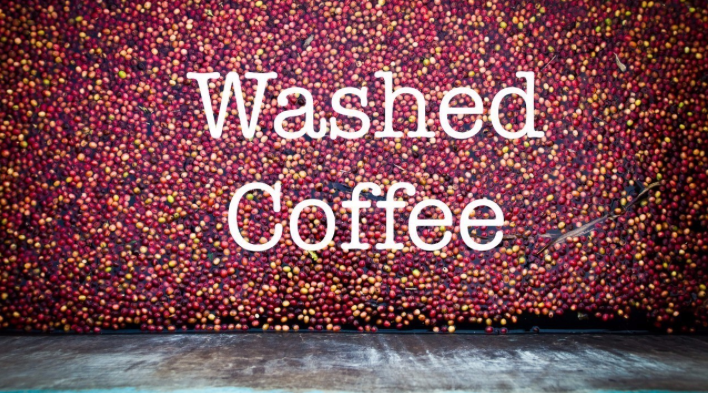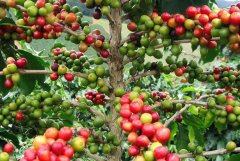Coffee bean treatment method of washing, entry coffee must understand
What is water washing?
As coffee consumers, whether we buy freshly roasted coffee beans online or at a cafe, there is always information about the beans on the package: altitude, country of origin, region, some flavor labels, coffee bean species and coffee processing methods.
Personally, Leon, the last thing I really know about the above information is "processing" and "bean seed", and I believe that many coffee people are the same as me. The distinction between "processing" and "bean seed" is far more relevant to us as end consumers than the very objective information of "altitude, country of origin, region of origin," but it is also relevant to the flavor we eventually drink. Today, the bag uses a very clear way to introduce you to the "big brother" in the coffee treatment method-Washed/Fully Washed/Wet Process.

coffee fruit structure
Before we start, we need to understand the nature of coffee beans.
First of all, botanically speaking, coffee beans are not "beans", coffee fruit belongs to fruit. Yes, it looks like a bean, but judging from the fruit shape of the coffee plant, the coffee fruit looks more like a peach than a bean. What we usually call "coffee beans" is coffee as a plant seed.
Please carefully compare the above three pictures, if necessary, please Baidu encyclopedia.
That is to say, the coffee beans we usually see have four layers of substances on the outside: silver skin, endocarp/green bean shell, mesocarp/pulp & colloid, exocarp/red or yellow pericarp.
Why do people mistakenly refer to coffee as beans regardless of nationality? Mainly because people tend to ignore the pulp part of coffee fruit, coffee fruit pulp is too thin, the following is a coffee fruit and peach cross section.
We eat peaches in our lives by eating their pulp; we enjoy coffee by roasting its seeds and grinding them in water, while discarding all other rind and pulp. Plus coffee seeds look like beans, so everyone naturally calls them coffee beans. In the following description, for simplicity and ease of understanding, we still use the name of coffee beans, but everyone needs to have a number in mind that coffee beans are not beans.
What is the significance of the existence of treatment? Coffee seeds grow on trees, and when coffee farmers pick them, they look like this.
At this time, it is still the coffee fruit of the fruit body, the water content is still quite high, plus the sugar contained in the coffee pulp, piled together for a long time, it is easy to cause fermentation, mildew, produce various bad tastes, and even food safety problems.
People therefore have to find ways to convert coffee berries that are not suitable for long-distance transportation and storage into something stable and non-perishable. The idea is to remove all the pericarp, pulp and endocarp of the coffee fruit, and then dry the seeds. Water washing is one of many solutions. In 1740, it was invented by the Dutch while growing coffee in Java, Indonesia. People found that the coffee treated in this way tasted very clear and bright, and there were many mixed bad tastes, which popularized the water washing method. For a long time, the word "washed" almost became synonymous with "good coffee". In today's commercial coffee market, washed coffee is still the most expensive, but the cost of washing is also quite expensive.
step
If you are lazy, watch this bag translation video
In fact, under the water washing method, there are many "magic modified versions" of it. For simplicity and ease of understanding, we will only talk about washing in a narrow sense.
A. picking
B. immersion screening
It can be seen that the coffee fruits picked in the above picture are not the same in maturity. Workers pour the coffee fruits into a large pool. The immature coffee fruits float on the water surface because of their low density, while the mature coffee fruits sink to the bottom. Workers fish out the immature coffee fruits for disposal, and the rest of the coffee fruits are taken to the next stage.
C. mechanical peeling
Ripe coffee cherries are fed with water to a machine that scrapes the outer skin of the coffee cherries. The machine also scrapes most of the pulp from the coffee cherries, but a small layer of pectin remains stuck to the shell of the green coffee beans. Washed coffee follows the principle of "make no mistake" and kills any factors that may affect coffee flavor in the cradle. For example, at this step, the influencing factors of coffee pulp on coffee flavor are almost completely eliminated, ensuring the "cleanliness" of washed coffee. The stripped beans flow down the canal to their next stop.
D. Pectin removal (fermentation or mechanical scraping)
At this point, the coffee beans with a small amount of gum on the surface, accompanied by already sticky water, flow into another large pool. Pectin adhesion is strong, peeling machine can not directly scrape down, at this time need stronger force. Either put it in a fermentation tank for static fermentation, and remove pectin by using the bacteria's ability to decompose colloid; or use a more powerful machine to brush off all colloid on the surface of coffee beans.
First of all, fermentation, coffee farmers will pour the coffee beans into the fermentation tank at this time, then pour the water of the same quality as the coffee beans, and let stand for 8 to 40 hours. The specific time depends on factors such as temperature and humidity, cost, production area, habits and even mood. Only one fermentation, the most famous magic modified version is the "two-stage" washing fermentation method in most of Kenya's production areas. Generally, fermentation is a one-time end, Kenyans will coffee into the fermentation tank for 24 to 36 hours, then take out, rinse with water, some organic products on the coffee surface washed off, and then put into the fermentation tank for 24 to 36 hours, and then take out cleaning. "Two-stage" fermentation makes Kenya's caffeic acid more layered and mature.
During the fermentation process, workers need to constantly stir to make the coffee beans ferment evenly and make the pectin fall off fully. Although the idea of fermentation is still to remove pectin, which can affect coffee flavor, it also has some good or bad side effects on coffee. Good fermented coffee has moderate acidity and a special sour and sweet taste; poor fermented coffee is either too sour or has a fermented smell of alcohol and onion. See Coffee Flavor Wheel for details.
Coffee in the fermentation tank, slimy and disgusting
The sticky, viscous liquid in the fermentation tank must be treated as wastewater because it contains many bacterial fermentation products and other unspecified compounds. You can't even irrigate the fields. There is poison in this water.
It can be seen that when we talk about fermentation, three sentences do not leave a "water" word, indeed, for the washing method, water is absolutely the most important resource, those countries that lack water also lack the conditions to implement the washing method, here we will talk about a relatively compromise "washing method". That is, the mechanical scraping of pectin.
Mechanical scraping of pectin, at least very water saving, do not need to soak green beans, do not need to re-water coffee green beans, fast, but why is not widely used? Although mechanical scraping of pectin is very fast, and also achieved the purpose of killing pectin in the cradle of flavor, but this lacks the stage of coffee flavor development in the fermentation tank, mechanical scraping of coffee often flavor single, not particularly good to drink.
E. drying
Coffee beans that have been soaked in water are still high in moisture, while lower moisture content ensures that coffee can withstand long-term transportation and storage. Therefore, people need to dry coffee. The most widely used way is naturally air-drying + drying. Wet coffee beans are spread on concrete floors or on elevated net beds to withstand the baptism of sunlight and sea breeze. This step requires extra attention from coffee farmers, who must turn coffee beans frequently to ventilate them and avoid mildew due to excessive humidity. Green coffee beans need to be dried to a moisture content of 10% to 12% before being stored.
F. shelled
After drying, coffee beans need to be stored in the warehouse for at least 60 days, this step is called "beans". In some places, they can even grow for years to become so-called "aged beans," which are loved by many Japanese bakers. Before being shipped out, coffee beans in the shell are sent to a husker, which grinds away the endocarp, or seed coat, to become the familiar pale green coffee beans.
Other small information
Washed coffee is considered "high-grade" coffee because it eliminates almost all of the factors that negatively affect coffee. Washing not only preserves the original flavor of coffee, but also enhances the "brightness" of coffee, that is, acidity, and special fruit aroma. In general, washed coffee is the most acidic of all treatments.
Large-scale water washing is now used in Ethiopia, Kenya, Rwanda, Hawaii, Tanzania, Guatemala, El Salvador and Honduras.
If you have the chance, please try it compared with sun-baked coffee, you will find many differences, different countries of origin under the interpretation of different treatments, there are different charm.
Important Notice :
前街咖啡 FrontStreet Coffee has moved to new addredd:
FrontStreet Coffee Address: 315,Donghua East Road,GuangZhou
Tel:020 38364473
- Prev

The origin of latte (CoffeeLatte) latte Italian mix bean concentrate mixed milk
Latte (CoffeeLatte) is a kind of fancy coffee. The ultimate blend of coffee and milk, Italian latte for pure milk and coffee, American latte to replace part of the milk with milk foam, most of the local lattes are like this. The famous saying that I was not in the cafe was said by a musician in Vienna on the way to the cafe. In the air of Vienna, forever
- Next

Caramelization of coffee during roasting and Mena reaction roasting coffee bean roaster
A few days before Napoleon died on St. Helena Island in 1821, his attendant Marshal Bertrand wrote about Napoleon begging: "he asked for twenty times in the morning and asked me if I could give him some more coffee." "No, my lord, the doctor ordered you to drink only one spoonful of coffee. It's not time yet. You have a bad stomach. Drinking early will only make you vomit early. "he threw up nine times this morning.
Related
- Beginners will see the "Coffee pull flower" guide!
- What is the difference between ice blog purified milk and ordinary milk coffee?
- Why is the Philippines the largest producer of crops in Liberia?
- For coffee extraction, should the fine powder be retained?
- How does extracted espresso fill pressed powder? How much strength does it take to press the powder?
- How to make jasmine cold extract coffee? Is the jasmine + latte good?
- Will this little toy really make the coffee taste better? How does Lily Drip affect coffee extraction?
- Will the action of slapping the filter cup also affect coffee extraction?
- What's the difference between powder-to-water ratio and powder-to-liquid ratio?
- What is the Ethiopian local species? What does it have to do with Heirloom native species?

